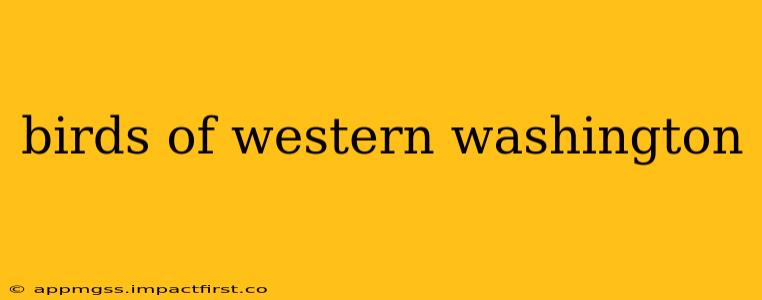Western Washington boasts a stunning array of avian life, from the majestic bald eagle to the tiny hummingbird. Its diverse habitats, ranging from lush rainforests to rugged coastlines, provide a rich tapestry of environments supporting a wide variety of bird species. This guide explores the fascinating world of birds found in this beautiful region, offering insights into their identification, habitat preferences, and conservation status.
What are some common birds found in Western Washington?
Western Washington's diverse ecosystems support a remarkable diversity of bird species. Some of the most common include:
- Bald Eagle: This iconic bird of prey is a frequent sight near water bodies, readily identifiable by its white head and tail.
- American Robin: A familiar sight in gardens and parks, the American Robin is easily recognized by its reddish-orange breast.
- Northern Flicker: This woodpecker is often seen on the ground foraging for ants. It has a distinctive spotted back and a black crescent on its chest.
- Steller's Jay: Known for its striking blue plumage and boisterous calls, the Steller's Jay is a common sight in coniferous forests.
- Black-capped Chickadee: A tiny but tenacious bird, the Black-capped Chickadee is a year-round resident, easily identified by its black cap and bib.
- Downy Woodpecker: The smallest woodpecker in the region, the Downy Woodpecker, is a frequent visitor to backyard bird feeders.
- Rufous Hummingbird: This tiny, energetic bird is a summer visitor, known for its iridescent plumage and rapid wingbeats.
This list only scratches the surface. The exact species you’ll see will depend heavily on location, season, and habitat.
What birds are in Western Washington in the winter?
Many bird species are year-round residents of Western Washington, while others migrate to the region for the winter. Winter visitors often include:
- Various waterfowl: Ducks, geese, and swans migrate to the region's numerous lakes and wetlands for the winter.
- Northern Pintail: A sleek, elegant duck often found in wetlands.
- Tufted Puffin: While not as common as other winter visitors, it can be spotted along the coast.
- Common Loon: This striking diving bird frequents larger lakes during winter.
Observing winter birds requires adapting to the often-challenging weather conditions. Warm layers and waterproof outerwear are essential for a comfortable birding experience.
What birds migrate to Western Washington in the spring and summer?
Spring and summer bring a wave of migratory birds to Western Washington, adding vibrant colors and sounds to the landscape. Some notable migrants include:
- Warblers: Many species of warblers breed in the region's forests and woodlands.
- Swallows: These agile aerial insectivores breed in various habitats.
- Flycatchers: These birds are skilled at catching insects in mid-air.
- Various shorebirds: Numerous species of shorebirds utilize the region's coastline and estuaries during their migrations.
Where are the best places to birdwatch in Western Washington?
Western Washington offers numerous exceptional locations for birdwatching. Some popular spots include:
- Point Defiance Park (Tacoma): Features diverse habitats, attracting a wide range of bird species.
- Ebey's Landing (Whidbey Island): Offers stunning coastal views and opportunities to spot seabirds.
- Washington Park Arboretum (Seattle): A beautiful urban oasis with diverse birdlife.
- Olympic National Park: Encompasses a vast array of habitats supporting a remarkable diversity of bird species.
- Various wildlife refuges: These protected areas provide important habitats for many bird species.
What is the best time of year to go birdwatching in Western Washington?
The best time for birdwatching in Western Washington depends on your target species. Spring and fall migrations offer the chance to see the greatest diversity of birds. However, winter provides opportunities to spot species that are only present during the colder months, and summer offers the chance to see nesting birds and their young.
What are some tips for birdwatching in Western Washington?
- Bring binoculars: Essential for observing birds at a distance.
- Dress in layers: Weather conditions can change rapidly.
- Use a field guide: Aids in bird identification.
- Respect wildlife: Maintain a safe distance from birds and their nests.
- Be patient: Birdwatching requires patience and observation skills.
This guide provides a starting point for exploring the rich avian biodiversity of Western Washington. Further research into specific habitats and species will enhance your birding experiences in this stunning region. Remember to always practice responsible and ethical birding practices, ensuring the preservation of these magnificent creatures and their habitats for generations to come.
